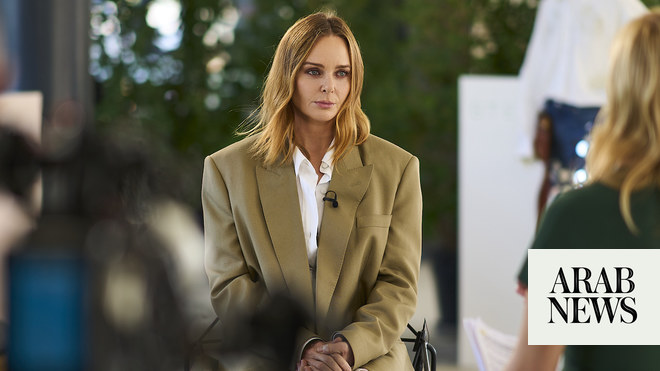
RIYADH: The Intermix residency program at JAX, the art district in Riyadh, has welcomed the public to its open studio showcase, featuring various works from local and global multidisciplinary and textile artists reimagining concepts of art and fashion.
Intermix, the first multidisciplinary residency to be launched by the Visual Arts Commission and Fashion Commission, aims to offer opportunities for designers and visual artists to exchange creative experiences and practices in a three-month program through the lens of innovation, transformation and sustainability.
The exhibition, from Nov. 9-19, showcases works from 13 artists, including Chakir Hani, Elham Dawsari, Huda Beydoun, Malik Thomas Jalil Kydd, Mashail Faqeeh, Sara Abdu, Shaima Saleh, Anthony “Qwan” Liguer Laubhouet.
Within the walls of a studio space, street artist Noor Ebrahim has transformed an empty vessel into a “SPACECRAFT,” also the title of her work, in an effort to create new memories and understandings of identity and belonging.
Her work challenges the idea of heterotopia, as she weaves new meaning to the concept with various shades of colored yarn. The installation stands alone, inviting the visitors to stand within its presence and experience the space under its constricted sculptural form.
“All of my artwork has psychedelic colors. This was meant to spark joy or happiness: Stepping into this bubble or pocket, you just feel happy, nothing else. That’s what these colors express to me,” Ebrahim told Arab News.
Walking into the main showcase space, the audience is met with streaks of sand, residues of another artwork by Hana AlMilli, accompanied by an auditory performance curated by resident Sara Abdu.
Saudi textile artist AlMilli’s work incorporates the diamond shape featured in most weaving patterns from her multicultural background. The textile piece is submerged in soil found in the JAX district, mixed with henna, hibiscus, lavender and other herbs. Slowly, within the next few days, the mixture will rise into the crevices of the fabric as it dyes the material in heritage in a work she titled “From the soil, I emerge.”
Half-Indian, half-Norwegian fashion and jewelry designer Helena Bajaj Larsen’s work was inspired by the inherited female practice Al-Qatt Al-Asiri, which depicts women in a painted triangular form. As she spotted the shape all over Riyadh, she began investing in the idea of herself and different cultures as a pyramid of value systems and sensibilities.
“It’s been a very self-led residency, but it’s been interesting in that sense as I’ve had to really get to know the city in a different way on my own and be quite resourceful, and I think it pushed me to discover things that I wouldn’t have otherwise,” Larsen told Arab News.
Jana Ghalayini’s work questions the temporal aspect of body and space as she plays around with the evolution of art — and herself — through painting, erasing, restructuring, transmitting, marking, and accepting. Her presentation is multifaceted, as she displays painting, weaving, printmaking, performance, video and sound in her work “Give Me Space to Breathe, and Let Me Show You How.”
“(Erasing the work) wasn’t painful, because with all my work, I have control, but I also understand that there are things that are out of my control,” Ghalayini told Arab News.
French artist Claire Dartigues, specialized in upcycling and mixing art, usually practices her craft by setting up her atelier in different places, from snowy mountains to busy markets, to bring the garments to life within the spaces they’re meant to be worn. She spent her time in Saudi, venturing into souqs, which later became a metaphor for local conversations in her artwork “Finding What You Were Not Looking For.”
Her studio acts as an open diary of her time in the Kingdom, focused on the role of the artist in creating visual narratives, transforming the scene and furthering public accessibility to fashion and art. At the core of her work, she explores the essential overarching question as an international artist: How does fashion matter to people in Saudi Arabia?
As her work questions masculinity and femininity as well, transforming the notions within those concepts to conform to a more conservative society meant taking the time to listen and understand.
“I feel what’s important is to go back to the roots of what is important to people. You have conservatism, but you also have the people, and what they like, for example, soccer, national identity, big dresses,” Dartigues told Arab News.
She showcases eclectic and eccentric garments upscaled from thrift soccer uniforms, tulle, sequins and other materials. The artist notes that even Europe was once a conservative continent, but evolution is only possible through people.
“The question is: Can I travel mountains, deserts, cities and rivers with my own clothes and my own self? I’m asking: Are we ready here to be ourselves while respecting the culture?” she said.
For her, the process of upcycling clothes is one of transmittance; it forward the story while also promoting ethical and sustainable fashion codes.
“I didn’t see it as upcycling things or sustainable things, I saw it as heritage…You can make clothes all over the world. Globalization can be positive but has to be made with respect to the humans behind making the clothes and the little hands that are dying to make clothes for big corporations,” she said.












